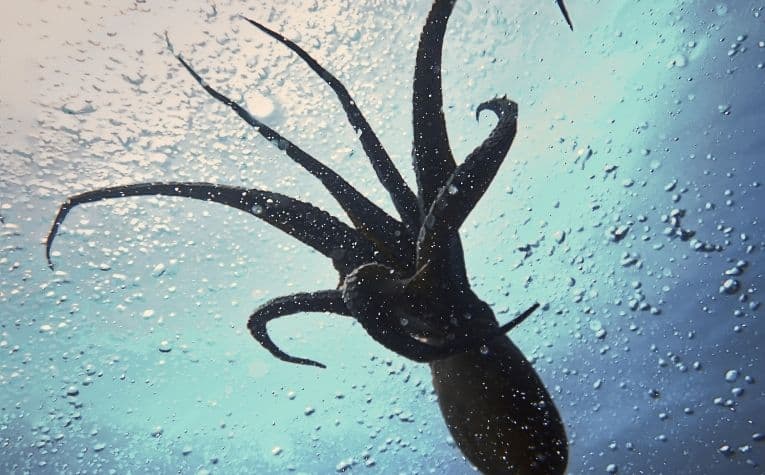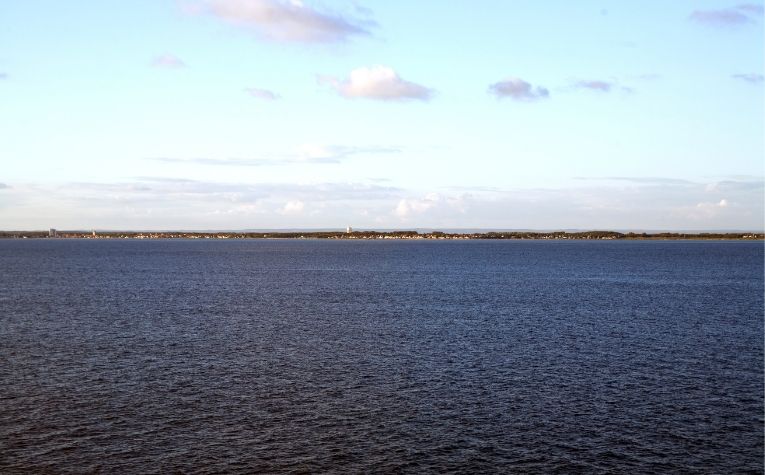Nordic legends and mythology are chock full of fantastical creatures that add to the richness and vividness of tales told through the centuries. However, some tales of mythical creatures were rooted in reality.
Scientific data strongly supports the notion that the Kraken myth is based on real-life encounters with the giant squid ages ago.
Known to inhabit the deep waters off Norway and Greenland, this mysterious cephalopod inspired Kraken legends owing largely to its incredible size and menacing features.
For much of their history, Scandinavians have been seafaring people.
Therefore, it should come as no surprise that Norse sailors navigating the waters of the North Atlantic through the centuries would have observed mysterious sea creatures on their countless voyages.
Scholars believe that encounters with the giant squid gave rise to the fearsome Kraken’s legends and that the two are one and the same.
Also, see Has Anyone Seen the Kraken? to learn more.

Is the Kraken a Squid or an Octopus? The Verdict
Although it is difficult to say precisely how or when the original Kraken myth came to be, what is certain is that it rose to prominence in Nordic folklore.
By the 12th century, tales of the ocean-dwelling creature were so widespread that King Sverre of Norway wrote of the Kraken in his accounts of various sea creatures that lived in nearby waters.
Norse sagas also got into the act, featuring the Kraken and pitting it against mythological heroes in works such as the Orvar Oddr.
Even centuries later, in 1735, despite having never seen one in person, in his work Systema Naturae renowned taxonomist Carl Linnaeus classified the Kraken as a cephalopod, with the likes of:
- Cuttlefish
- Octopuses
- Perhaps most significantly, squid [1]

Also, see Is the Kraken a Myth? to learn more.
Characteristics of the Mythical Kraken
As the Kraken’s legend grew, details of the sea monster’s attributes became more well-defined so that a clearer picture of the creature emerged.
Once descriptions of the Kraken varied wildly from person to person, the consensus characterization became more and more squid-like over time.
From the legends passed down from generation to generation, the most striking features of the Kraken were:
- Its gargantuan size, with a flat body so large that when partially submerged, it could be mistaken for a remote island
- Serpent-like arms that, when outstretched from the water, could reach the tops of even the tallest masts and wrap completely around entire ships and effortlessly rip them apart into splinters
- The ability to create a powerful vortex in the water resulting in a giant whirlpool that could pull a ship and its helpless crew beneath the surface to a watery grave
- Appalling feeding habits that involved turning the surrounding waters dark and muddy, regurgitating partially digested fish to attract its next meal, and engulfing whole schools of fish at one time [2]

Also, see What Dragons Meant to Vikings to learn more.
A creature “full of arms”
The first hints as to the Kraken’s true identity were recognized in the 18th century by a Danish historian named Eric Pontopiddan, who, based on interviews with Scandinavian fishermen, described the creature’s appearance as “round, flat, and full of arms” in his written work Natural History of Norway.
Other attributes of the Kraken that are similar to those of the giant squid include:
- Its enormous size
- Its elusiveness and preference to live far beneath the surface in the darkest depths of the ocean
- Its many, long tentacles
And what may be the most swaying factor,
- Its ability to “muddy” surrounding water (a likely reference to telltale squid ink)
When put together, these factors point to none other than the giant squid, which is a conclusion that most historians and scientists support wholeheartedly. [3] (Also see The Norse Tree of Life: A Fascinating Viking Symbol)
What is Known Today about the Elusive Giant Squid
Centuries after they were first described by bewildered sailors and fishermen navigating the frigid waters surrounding Scandinavia and Greenland, giant squid (scientific name Architeuthis dux), remain mysterious creatures.
Even with powerful tools and modern technology at their disposal, scientists admit that there are more questions than answers when it comes to the giant squid.
Much of what has been learned about these gigantic cephalopods has been gained by studying carcasses that have risen from the depths and washed ashore. There is no giant squid currently in captivity.
It was not until 2012 that a joint effort between Japanese scientists and a team from the Discovery Channel was finally able to capture video footage of a giant squid in its natural habitat deep under the sea.
What is clear, however, is that judging from some of its physical attributes alone, it would not be a stretch of the imagination at all to see how and why mariners from nearly a millennium ago portrayed the elusive giant squid as an ocean-dwelling beast to be feared and respected:
- The eyes of the giant squid are the largest in the animal kingdom, measuring 12 inches (30 centimeters) in diameter, and would certainly have been an imposing sight peering out from the water
- In addition to having eight arms (each covered with 2-inch wide suckers), giant squid also have two feeding tentacles that are twice as long as their arms and can ensnare prey from over 30 feet away (and are also studded with suckers tipped with sharp points)
- To eat its prey, the giant squid slices through flesh with its powerful, vise-like beak, which is located at the confluence of its arms (the only known predator of the giant squid are sperm whales, and beaks have been found in their stomachs)
- Architeuthis dux are known to reach lengths of over 40 feet, and based on recent data suggesting that beaks can be used to estimate the length of the giant squid accurately, scientists now believe that they can grow to an incredible 66 feet in length [4]
Also, see 14 Great Books on Norse Mythology that explain the gods, heroes, and villains of these ancient stories of Scandinavia.
History of the Kraken
Throughout history, many cultures and civilizations believed in mythical creatures and beings that lived in the sea.
The Scandinavians were no different, and some scholars believe that the Kraken evolved from a whale-like beast in ancient Nordic folklore known as the Hafgufa.
Unlike the Kraken, which was portrayed as a violent and dangerous apex predator that mariners were best advised to avoid at all costs, the Hafgufa was best known for its unique feeding habits.
The precursor to the Kraken lured massive schools of fish to its vicinity by regurgitating previous meals into the water and then swallowing up its prey, much like a whale gulping down a ton of krill with one giant mouthful.
As far as its name, scholars theorize that the term “Kraken” was coined to describe the manner in which the beast preyed on ships and caused the demise of many unfortunate sailors:
- “At kraka” is an Old Norse verb meaning “to drag downward,” as in the long powerful arms of the Kraken encircling a ship and pulling the entire vessel into the water
- “Kraki” is an Old Norse noun meaning “boat hook” or “anchor,” suggesting an object sinking into the depths toward the ocean floor, again conjuring images of the Kraken grabbing hold of a ship and dragging it deep beneath the surface, never to be seen again
By the 18th century, the word Kraken was firmly tied to the giant squid-like creature that gave even the most seasoned mariners pause whenever a disturbance was spotted in the water for fear that the sea beast was lurking beneath the surface. [5] [6]
Conclusion
Fanciful beasts have stirred the imagination of Norse people for centuries. From the mighty serpent Jormungandr, so colossal that its body encircled the entire world, to the giant wolf Fenrir, the harbinger of the apocalypse and nemesis of Odin.
Yet it seems more is being learned about the Kraken. After centuries of being feared, misunderstood, and even disparaged, some of the mysteries surrounding the giant squid, aka the Kraken, are finally being solved.
References:
[1] Smithsonian
[2] Source
[3] Source
[4] Source
[5] history.com
[6] washington.edu
